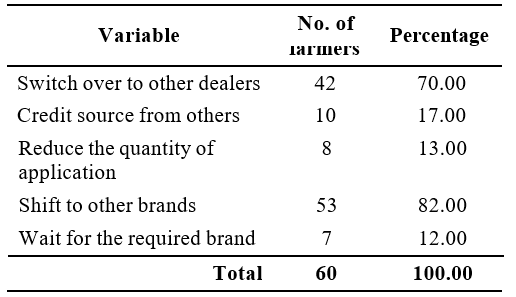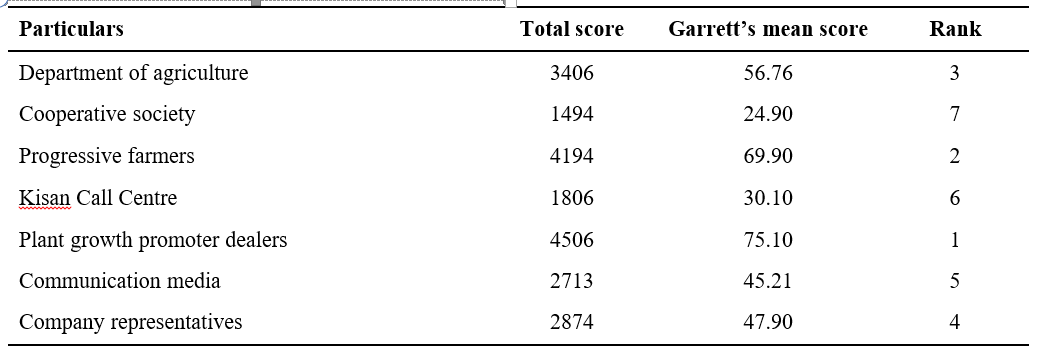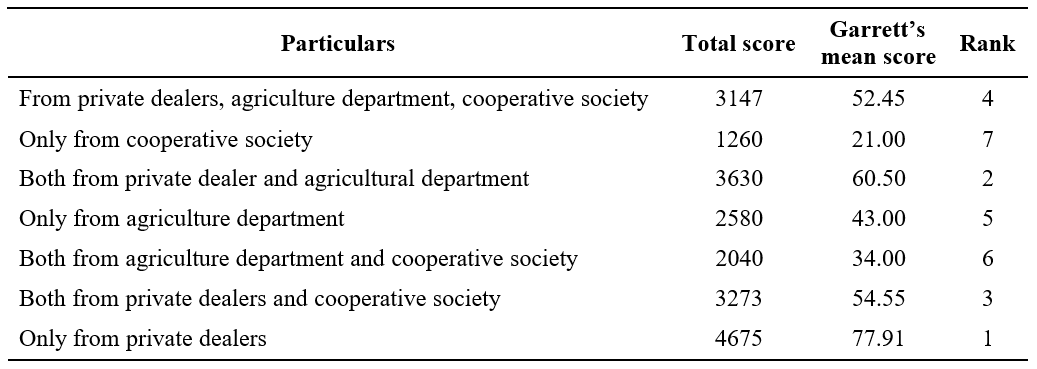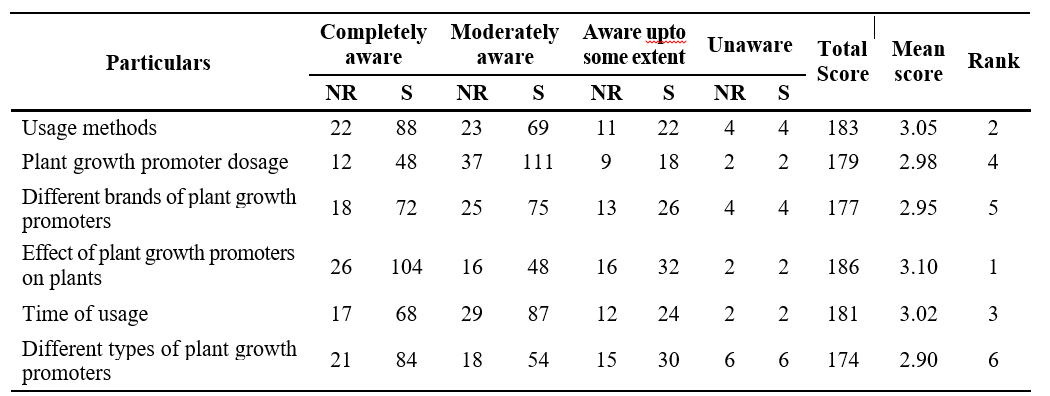Buying Behaviour of Farmers Towards Plant Growth Promoters in Chittoor District of Andhra Pradesh
0 Views
Y.ANANYA DEVI*, S. HYMA JYOTHI, I. BHAVANI DEVI AND P. LAVANYA KUMARI
Department of Agribusiness Management, Institute of Agribusiness Management,
S.V. Agricultural College, ANGRAU, Tirupati
ABSTRACT
The present study was to know the factors influencing the farmers buying behaviour towards plant growth promoters and constraints faced by farmers purchasing process in Chittoor district of Andhra Pradesh. Sample farmers were cultivating mango, tomato and chrysanthemum. Chittoor district was purposively selected as it occupies first place gross area sown in Andhra Pradesh. The analytical tools employed were percentages, Garrett’s ranking technique and Likert’s scale technique. Price was the major constraint while purchasing of plant growth promoters, awareness towards results of the plant growth promoters was high and not much aware of different types and brands of the plant growth promoters.
KEYWORDS: Buying behaviour, Garrett’s ranking and Likert’s scale
INTRODUCTION
Agriculture is the primary source of livelihood up to 58 per cent of India’s population. With increasing population, demand for food and agricultural production is inevitable.
Apart from the essentials like oxygen, water, sunlight, it is the harmones that modulate the growth of individual plant parts and controls various physiological activities. The plant growth regulators are also called as plant growth harmones or phytoharmones which are either synthesized in the laboratory or produced naturally within the plant. Plant growth regulators are of two major groups one that promotes the growth and the other that retards the growth of the plants. The global market of plant growth regulators is driven by declining farming area coupled with increasing demand for organic food. The Humic acid global market is estimated to grow by CAGR of 14 percent by 2026 from 510.9 million USD in 2018. (Anonymous, 2018). Agriculture application being the largest segment with 55 percent market share. (Anonymous, 2022.) The common source of purchasing the plant growth promoters by farmers is through local dealers. Dealers not only sell to farmers but also play important role in the source of information about the products and their distribution function, also influencing the amount and type of plant growth promoters used by farmers. Buying decision is a set of many decisions which may involve a product, brand, quality, dealers, time and price. The objective was set to study the buying behaviour of farmers and constraints faced by them in purchasing plant growth promoters.
MATERIAL AND METHODS
For this study Chittoor district was purposively selected as it occupies first place gross area sown in Andhra Prades. Two mandals of Chittoor district were selected. Three villages from each mandal were identified and from each village 10 farmers were selected randomly, making a sample size of 60 farmers. A well framed schedule was developed based on objectives. Primary data was collected using personal interview method. The data was collected for the month of August and the year 2021. Secondary data required was collected from authenticated sources and other e-resources. Descriptive statistics and appropriate statistical tools like percentage analysis, Garrett’s ranking, Likert’s scaling were employed in the study.
RESULTS AND DISCUSSIONS
Factors influencing and constraints faced by the farmers towards plant growth regulators
For farmers major source of information about plant growth promoters were dealers. Most of the farmers prefer credit sales, if credit sales were not available, most of the farmers had switched to dealers those providing credit Buying behaviour to farmers in purchasing plant growth promoters (70.00%) and if required brand is not available majority of the farmers were shifting to other brand (82.00%) and only (12.00%) of them wait for the required brand (Yeshwanth et al., 2019).
Table. 1. Farmer’s decision during the non-availabil- ity of required plant growth promoter brand

Table.2 Source of information on plant growth promoters

Table 2 revealed that regarding the source of information was through dealers as farmers were not much aware of plant growth promoters, relying on dealers followed by progressive farmers, department of agriculture, company representatives, communication media, kissan call centers and cooperative societies were ranked least as there were no such provisions for farmers (Gaikwad and Jirali, 2016).
Table 3 depicted that most of the farmers were purchasing plant growth promoters from private dealers as they were getting information of plant growth promoters, followed by both the sources from private dealers and agriculture department, among them farmers highly preferring private dealers alone, agriculture department and cooperative societies alone were least ranked as they were not aware of such provisions (Yeshwanth et al., 2019).
Constraints faced by the farmers during plant growth promoters purchase from private dealers
Table 4 revealed that the major constraint faced by the sample farmers was high price of plant growth promoters followed by high interest on credit as most of the farmers in the study area were purchasing plant growth promoters on credit basis and dealers making it as an advantage, they imposing high price for the borrowed. The other constraints were in the order offer of adulteration, poor quality of the products, no discount during bulk purchases which was not forth coming, lack of credit availability, and non-availability of preferred brands (Dharmaraj et al., 2013 and Jain et al., 2017).
Awareness of farmers towards plant growth promoters
Table 5 depicts that sample farmers awareness was first ranked among the factors was effect of plant growth promoters on crops, followed by usage methods, time of usage, followed by dosage of plant growth promoters and least ranked on the awareness of different types and brands (Sreekanth, 2018).
- Major source of information regarding plant growth promoters were
- Majority of the plant growth promoters purchases were from private dealers on credit basis and shift over to dealer who provide credit if, credit sales were not
Table 3. Source of plant growth promoters purchase by sample farmers

Table 4. Constraints during the purchase of plant growth promoters from the private dealers

Table 5. Awareness of farmers on usage of plant growth promoters

- If required brand was not available most of them were shifting to other brands, few of them were waiting for the required
- Most of the farmers were purchasing from private dealers only, none of them were purchasing from agriculture department or cooperative society
- High price was the major constraint faced by the farmers during the purchase of plant growth promoters from private
- Farmers awareness was first ranked with effect of plant growth promoter on crops. Different kinds and different types of brands were ranked fifth and sixth
LITERATURE CITED
Anonymous. 2022. https://www.marketsandmarkets .com/ Market-Reports/plant-growth-regulators-market- 94580110.html.
Dharmraj, S., Panchal, N.V and Desai, P. 2013. Consumer buying behavior towards agriculture inputs. International Global Research Analysis. 2(6): 117- 118.
Gaikwad, S.B and Jirali, D.I. 2016. Farmers perception of pesticide residue management in brinjal. Department of Crop Physiology, University of Agriculture Science, Dharwad. 16(1): 390-394.
Jatin, P., Shastrihasumati, D., Thakar, K.P and Joshi, K.M. 2017. Constraints faced by the farmers and dealers in purchasing and selling fertilizers in Banaskantha district of North Gujarat. International Journal of Agriculture Sciences. 9(3): 3683-3685.
Sreekanth, M.V. 2018. Buying behavior of farmers towards pesticides in Guntur district of Andhra Pradesh. Thesis submitted to Acharya. N.G. Ranga Agricultural University Lam, Guntur, Andhra Pradesh.
Yeshwanth, C., Vani, N., Aparna, B. and Ramanamurthy, 2019.Farmers pesticides buying behaviour: estimating the influential factors and constraints in Kurnool district of Andhra Pradesh. Indian Journal of Pure and Applied Biosciences. 9(4): 124-128.
- Bio-Formulations for Plant Growth-Promoting Streptomyces SP.
- Brand Preference of Farmers for Maize Seed
- Issues That Consumer Experience Towards Online Food Delivery (Ofd) Services in Tirupati City
- Influence of High Density Planting on Yield Parameters of Super Early and Mid Early Varieties of Redgram (Cajanus Cajan (L.) Millsp.)
- Influence of Iron, Zinc and Supplemental N P K on Yield and Yield Attributes of Dry Direct Sown Rice
- Effect of Soil and Foliar Application of Nutrients on the Performance of Bold Seeded Groundnut (Arachis Hypogaea L.)

